Development of Low-Cost Portable Spectrometers for Detection of Wood Defects
Abstract
1. Introduction
2. Materials and Methods
2.1. Sample Collection
2.2. Spectroscopic Measurements
2.3. Prototypes Development
2.4. Data Evaluation and Mining
3. Results and Discussion
3.1. Quality Parameters of Logs Detectable by NIR Spectroscopy
3.2. Model Spectra of Wood and Wood Defects
3.3. Recognition of Wood Defects by Automatic Classification Methods
4. Conclusions and Practical Recommendations Regarding the Implementation of the (Prototype) Sensors for Wood Defects Detection
Author Contributions
Funding
Acknowledgments
Conflicts of Interest
Appendix A. Arduino Code for Hamamatsu C11708MA Micro-Spectrometer
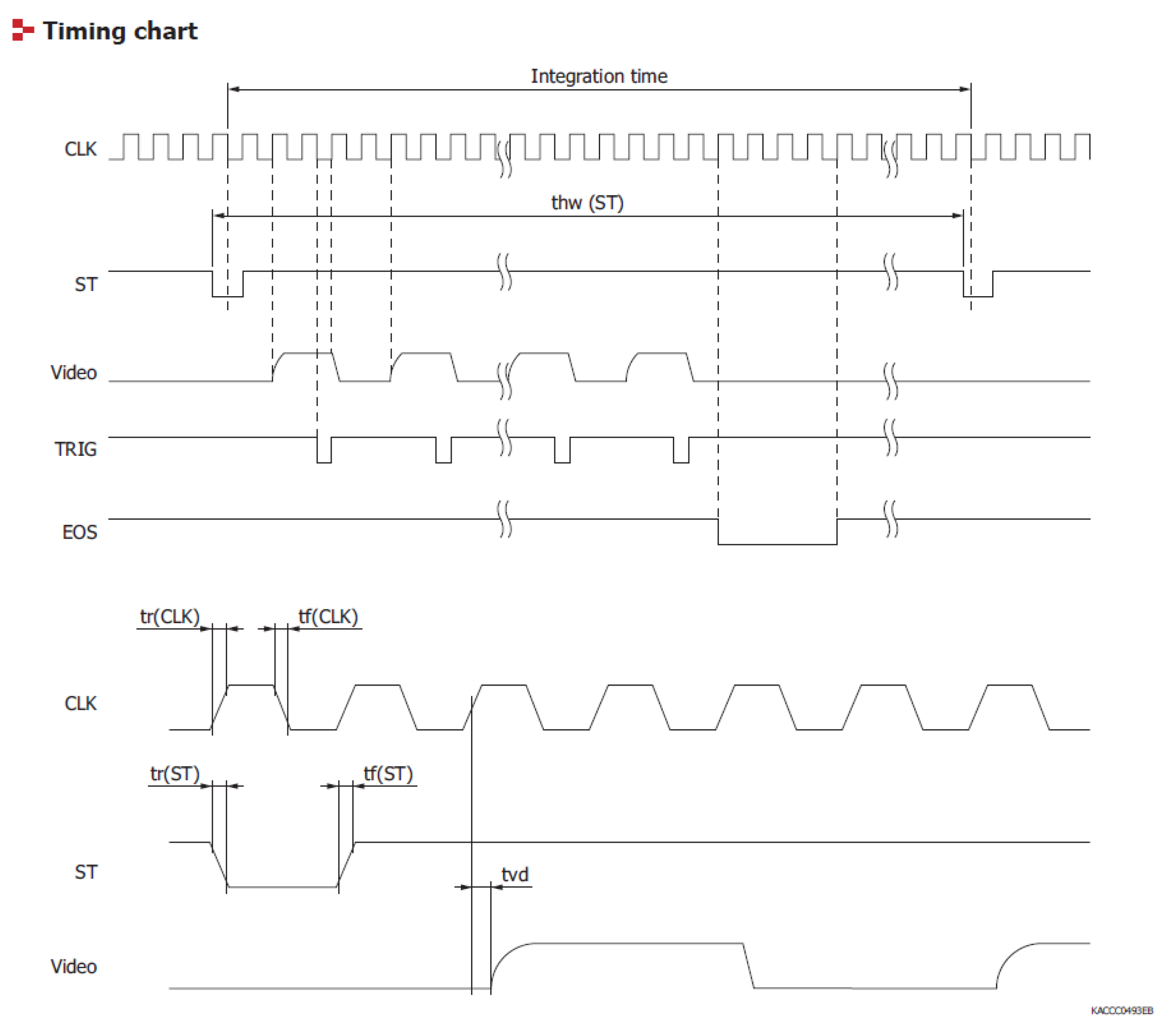
Appendix B. Arduino Code for Hamamatsu C12880MA Micro-Spectrometer
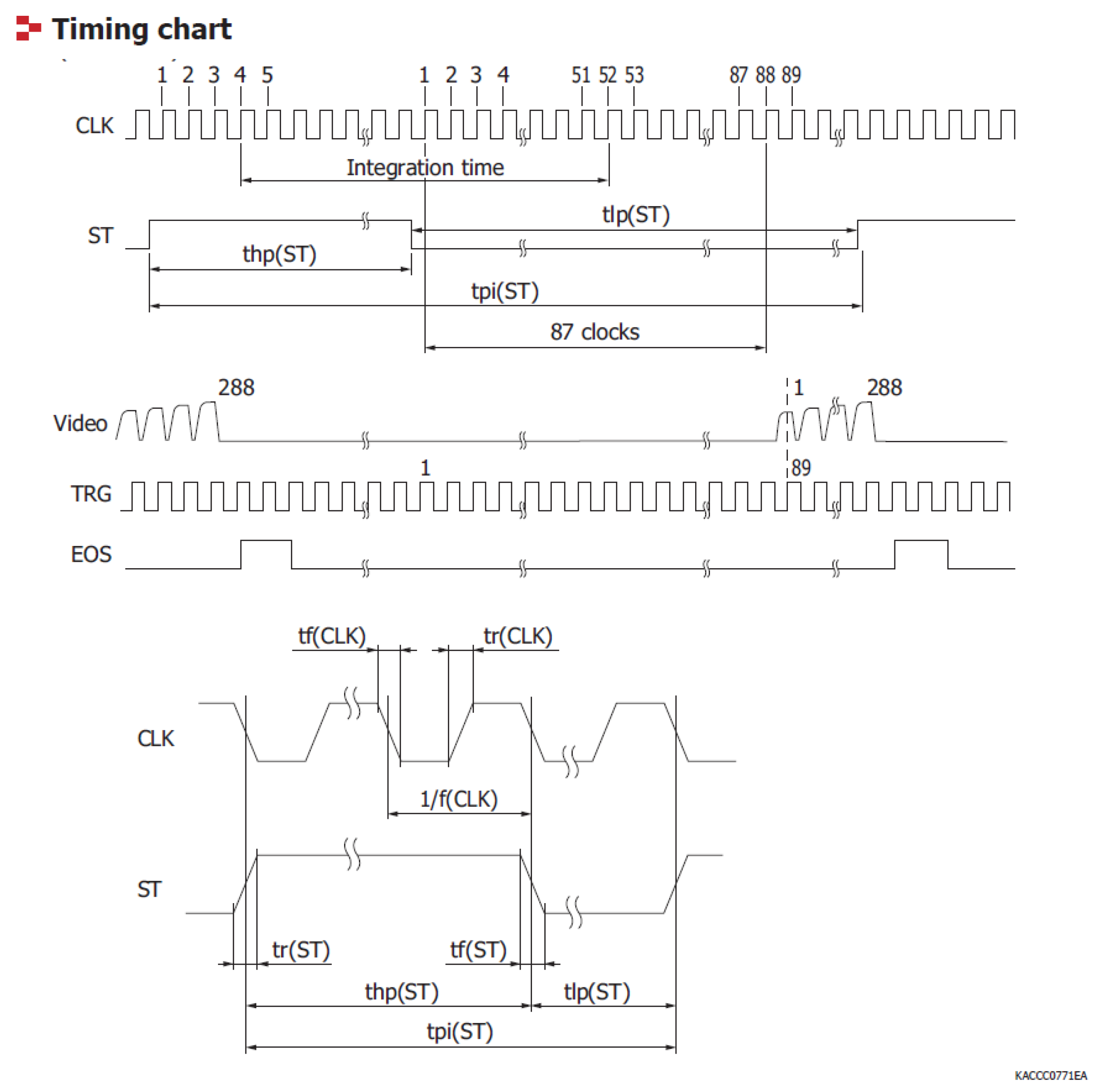
References
- Ministry of Forests, Lands and NRO. Scaling Manual. Available online: https://www2.gov.bc.ca/assets/gov/farming-natural-resources-and-industry/forestry/timber-pricing/harvest-billing/timber-scaling/scaling2011novmaster.pdf (accessed on 20 November 2019).
- Pollini, C. Manuale per la Classificazione Visuale Qualitativa del Legno Tondo di Abete Rosso, Abete Bianco e Larice; Servizio Foreste e Fauna e CNR IVALSA: Trento, Italy, 2006; p. 112. [Google Scholar]
- Sandak, A.; Sandak, J.; Böhm, K.; Zitek, A.; Hintestoisser, B. Near infrared spectroscopy as a tool for in-field determination of log/biomass quality index in mountain forests. J. Near Infrared Spectrosc. 2016, 24, 587–594. [Google Scholar] [CrossRef]
- Schimleck, L.R.; Matos, J.L.M.; Trianoski, R.; Prata, J.G. Comparison of Methods for Estimating Mechanical Properties of Wood by NIR Spectroscopy. J. Spectrosc. 2018, 2018, 4823285. [Google Scholar] [CrossRef]
- Lengowski, E.C.; Muñiz, G.; de Klock, U.; Nisgoski, S. Potential use of NIR and visible spectroscopy to analyze chemical properties of thermally treated wood. Maderas. Cienciay Tecnol. 2018, 20, 627–640. [Google Scholar] [CrossRef]
- Schimleck, L.; Antony, F.; Mora, C.; Dahlen, J. Comparison of Whole-Tree Wood Property Maps for 13- and 22-Year-Old Loblolly Pine. Forests 2018, 9, 287. [Google Scholar] [CrossRef]
- Li, Y.; Via, B.K.; Cheng, Q.; Zhao, J.; Li, Y. New Pretreatment Methods for Visible–Near-Infrared Calibration Modeling of Air-Dry Density of Ulmus pumila Wood. For. Prod. J. 2019, 69, 188–194. [Google Scholar]
- Andrade, C.R.; Trugilho, P.F.; Napoli, A.; da Silva Vieira, R.; Lima, J.T.; de Sousa, L.C. Estimation of the mechanical properties of wood from Eucalyptus urophylla using near infrared spectroscopy. Cerne 2010, 16, 291–298. [Google Scholar] [CrossRef]
- Meder, R. Near infrared spectroscopy: Seeing the wood in the trees. NIR News 2016, 27, 26–28. [Google Scholar] [CrossRef]
- Sandak, J.; Sandak, A.; Meder, R. Assessing trees, wood and derived products with NIR spectroscopy: Hints and tips. J. Near Infrared Spectrosc. 2016, 24, 485–505. [Google Scholar] [CrossRef]
- Hein, P.R.G.; Pakkanen, H.K.; Santos, A.A.D. Challenges in the use of Near Infrared Spectroscopy for improving wood quality: A review. For. Syst. 2017, 26, 10. [Google Scholar] [CrossRef]
- Schimleck, L. Near infrared spectroscopy: A rapid non-destructive method for measuring wood properties and its application to tree breeding. N. Z. J. For. Sci. 2008, 38, 14–35. [Google Scholar]
- Meder, R.; Brawner, J.T.; Downes, G.M.; Ebdon, N. Towards the in-forest analysis of Kraft pulp yield: Comparing the in-laboratory performance of laboratory and handheld instruments and their value in screening breeding trials. J. Near Infrared Spectrosc. 2001, 19, 5. [Google Scholar]
- Meder, R. The magnitude of tree breeding and the role of near infrared spectroscopy. NIR News 2015, 26, 3. [Google Scholar] [CrossRef]
- Li, Y.; Via, B.K.; Cheng, Q.; Li, Y. Lifting Wavelet Transform De-noising for Model Optimization of Vis-NIR Spectroscopy to Predict Wood Tracheid Length in Trees. Sensors 2018, 18, 4306. [Google Scholar] [CrossRef] [PubMed]
- Hsieh, E.; Uy, N.; Wallbacks, L. Development of a Portable Spectroscopic Sensor to Measure Wood and Fibre Properties in Standing Mountain Pine Beetle-Attacked Trees and Decked Logs; Mountain Pine Beetle Initiative Working Paper 2006-16; Natural Resources Canada, Canadian Forest Service, Pacific Forestry Centre: Victoria, BC, Canada, 2006; ISBN 0-662-44351-9.
- Da Silva, D.; Pastore, T.C.M.; Soares, L.F.; de Barros, F.A.S.; Bergo, M.C.J.; Coradin, V.T.H.; Gontijo, A.B.; Sosa, M.H.; Chacón, C.B.; Braga, J.W.B. Determination of the country of origin of true mahogany (Swietenia macrophylla King) wood in five Latin American countries using handheld NIR devices and multivariate data analysis. Holzforschung 2018, 72, 521–530. [Google Scholar] [CrossRef]
- Hans, G.; Leblon, B.; Cooper, P.; la Rocque, A.; Nader, J. Determination of moisture content and basic specific gravity of Populus tremuloides (Michx.) and Populus balsamifera (L.) logs using a portable near-infrared spectrometer. Wood Mater. Sci. Eng. 2015, 10, 3–16. [Google Scholar] [CrossRef]
- Warburton, P.; Brawner, J.T.; Meder, R. Handheld NIR spectroscopy for the prediction of leaf physiological status in tree seedlings. J. Near Infrared Spectrosc. 2014, 22, 433–438. [Google Scholar] [CrossRef]
- Watanabe, K.; Mansfield, S.D.; Avramidis, S. Application of near-infrared spectroscopy for moisture-based sorting of green hem-fir timber. J. Wood Sci. 2001, 57, 288–294. [Google Scholar] [CrossRef]
- Tsuchikawa, S.; Kobort, H.; Inagaki, T.; Fujimoto, T. Fast online near infrared technique to predict modulus of elasticity and moisture content of sawn lumber. In Proceedings of the 11th European Conference on Non-Destructive Testing (ECNDT 2014), Prague, Czech Republic, 6–10 October 2014. [Google Scholar]
- Lestander, T.A.; Johnsson, B.; Grothage, M. NIR techniques create added values for the pellet and biofuel industry. Bioresour. Technol. 2009, 100, 1589–1594. [Google Scholar] [CrossRef]
- Murray, H. Overview and Comparison of Portable Spectroscopy Techniques: FTIR, NIR and Raman; Analytic Ltd Whitepaper; Analytic Ltd.: Cambridge, UK, 2012; p. 9. [Google Scholar]
- Santos, C.; Lopo, M.; Páscoa, R.; Lopes, J.A. A Review on the Applications of Portable Near-Infrared Spectrometers in the Agro-Food Industry. Appl. Spectrosc. 2013, 67, 1215–1233. [Google Scholar] [CrossRef]
- Cao, J.; Liang, H.; Lin, X.; Tu, W.; Zhang, Y. Potential of near-infrared spectroscopy to detect defects on the surface of solid wood boards. BioResources 2017, 12, 19–28. [Google Scholar] [CrossRef][Green Version]
- Abd-Elrahman, A.; Pand-Chhetri, R.; Vallad, G. Design and Development of a Multi-Purpose Low-Cost Hyperspectral Imaging System. Remote Sens. 2011, 3, 570–586. [Google Scholar] [CrossRef]
- Sandak, A.; Ferrari, S.; Sandak, J.; Allegretti, O.; Terziev, N.; Riggio, M. Monitoring of wood decay by near infrared spectroscopy. Adv. Mater. Res. 2013, 778, 802–809. [Google Scholar] [CrossRef]
- Vane, C.H.; Drage, T.C.; Snape, C.E. Bark decay by the white-rot fungus Lentinula edodes: Polysaccharide loss, lignin resistance and the unmasking of suberin. Int. Biodeterior Biodegrad. 2006, 57, 14–23. [Google Scholar] [CrossRef]
- Zhang, S.Y. Wood Quality Attributes and Their Impacts on Wood Utilization. In Proceedings of the XII World Forestry Congress, Quebec, QC, Canada, 21–28 September 2003. [Google Scholar]
- Sandak, A.; Sandak, J.; Negri, M. Relationship between near-infrared (NIR) spectra and the geographical provenance of timber. Wood Sci. Technol. 2011, 45, 35–48. [Google Scholar] [CrossRef]
- Schwanninger, M.; Rodrigues, J.; Fackler, K. A review of band assignment in near infrared spectra of wood and wood components. J. Near Infrared Spectrosc. 2011, 99, 287–308. [Google Scholar] [CrossRef]
- Vagnini, M.; Miliani, C.; Cartechini, L.; Rocchi, P.; Brunetti, B.G.; Sgamellotti, A. FT-NIR spectroscopy for noninvasive identification of natural polymers and resins in easel paintings. Anal. Bioanal. Chem. 2009, 395, 2107–2118. [Google Scholar] [CrossRef]
- Owen, A.J. Uses of Derivative Spectroscopy. Application Note: UV-Visible Spectroscopy; Agilent Technologies: Waldbronn, Germany, 1995; p. 8. [Google Scholar]
- Holmbom, T.; Reunanen, M.; Fardim, P. Composition of callus resin of Norway spruce, Scots pine, European larch and Douglas fir. Holzforschung 2008, 62, 417–422. [Google Scholar] [CrossRef]
- Berrueta, L.A.; Alonso-Salces, R.M.; Héberger, K. Supervised pattern recognition in food analysis. J. Chromatogr. A 2007, 1158, 196–214. [Google Scholar] [CrossRef]
- Tian, Y.; Wang, Z.; Han, X.; Hou, H.; Zheng, R. Comparative investigation of partial least squares discriminant analysis and support vector machines for geological cuttings identification using laser-induced breakdown spectroscopy. Spectrochim. Acta B 2014, 102, 52–57. [Google Scholar] [CrossRef]
- Gromski, P.S.; Muhamadali, H.; Ellis, D.I.; Xu, Y.; Correa, E.; Turner, M.L.; Goodacre, R. A tutorial review: Metabolomics and partial least squares-discriminant analysis—A marriage of convenience or a shotgun wedding. Anal. Chim. Acta 2015, 879, 10–23. [Google Scholar] [CrossRef]
- Hansen, W.G.; Wiedemann, S.C.C.; Snieder, M.; Wortel, V.A.L. Tolerance of near infrared calibrations to temperature variations; a practical evaluation. J. Near Infrared Spectrosc. 2000, 8, 125–132. [Google Scholar] [CrossRef]
- Kawano, S.; Abe, H.; Iwamoto, M. Development of a calibration equation with temperature compensation for determining the Brix value in intact peaches. J. Near Infrared Spectrosc. 1995, 3, 211–218. [Google Scholar] [CrossRef]
- Thygesen, L.G.; Lundqvist, S.O. NIR measurement of moisture content in wood under unstable temperature conditions. Part 1. Thermal effects in near infrared spectra of wood. J. Near Infrared Spectrosc. 2000, 8, 183–189. [Google Scholar] [CrossRef]
- Cheng, Q.; Zhou, C.; Jiang, W.; Zhao, X.; Via, B.; Wan, H. Mechanical and Physical Properties of Oriented Strand Board Exposed to High Temperature and Relative Humidity and Coupled with Near-Infrared Reflectance Modeling. For. Prod. J. 2018, 68, 78–85. [Google Scholar]
- Thygesen, L.G.; Lundqvist, S.O. NIR measurement of moisture content in wood under unstable temperature conditions. Part 2. Handling temperature fluctuations. J. Near Infrared Spectrosc. 2000, 8, 191–199. [Google Scholar] [CrossRef]
- Sandak, J.; Sandak, A.; Marrazza, S.; Picchi, G. Development of a sensorized timber processor head—Part 1: Sensor description and preliminary testing. Croat. J. For. Eng. 2019, 40, 25–37. [Google Scholar]
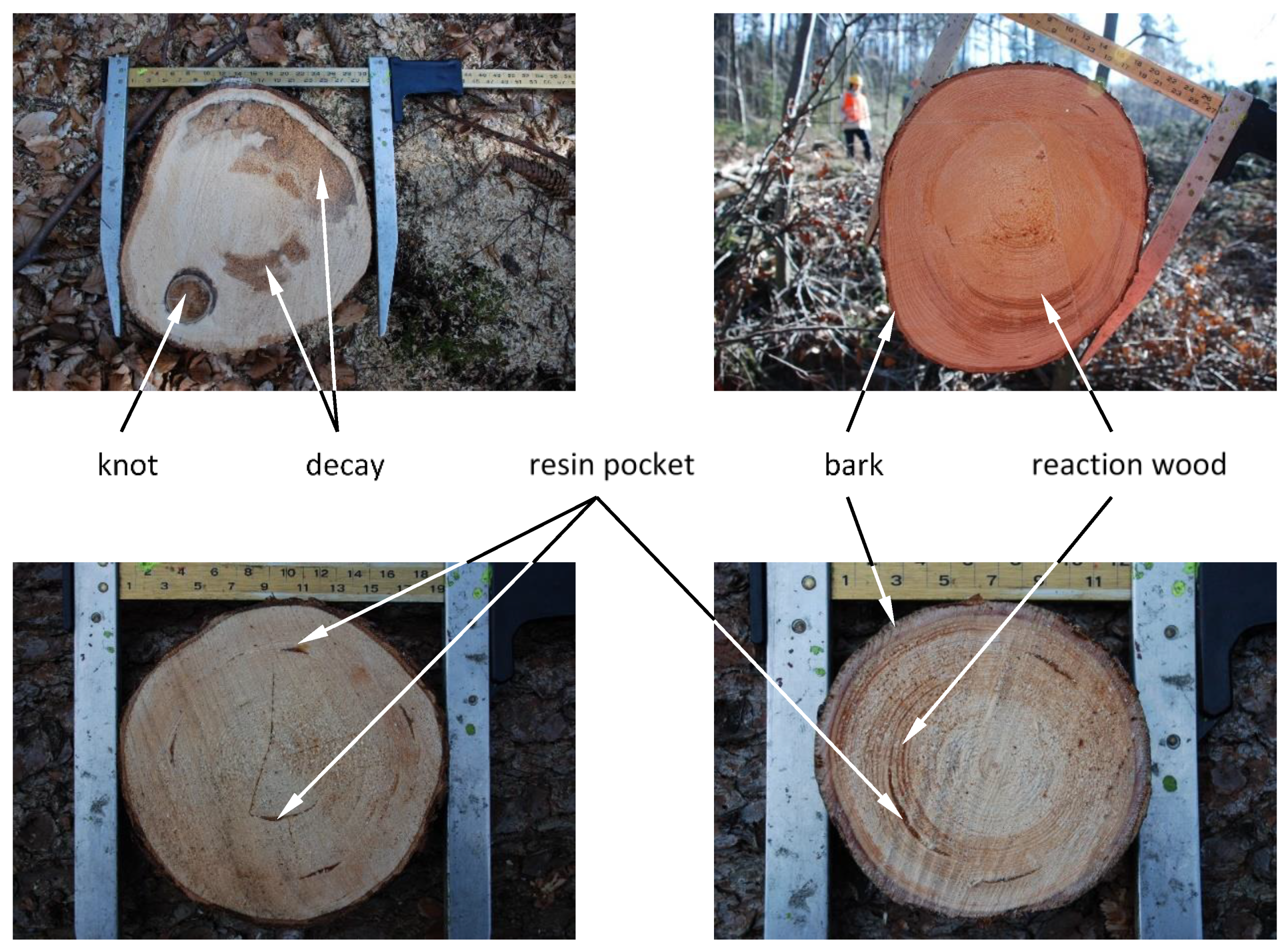
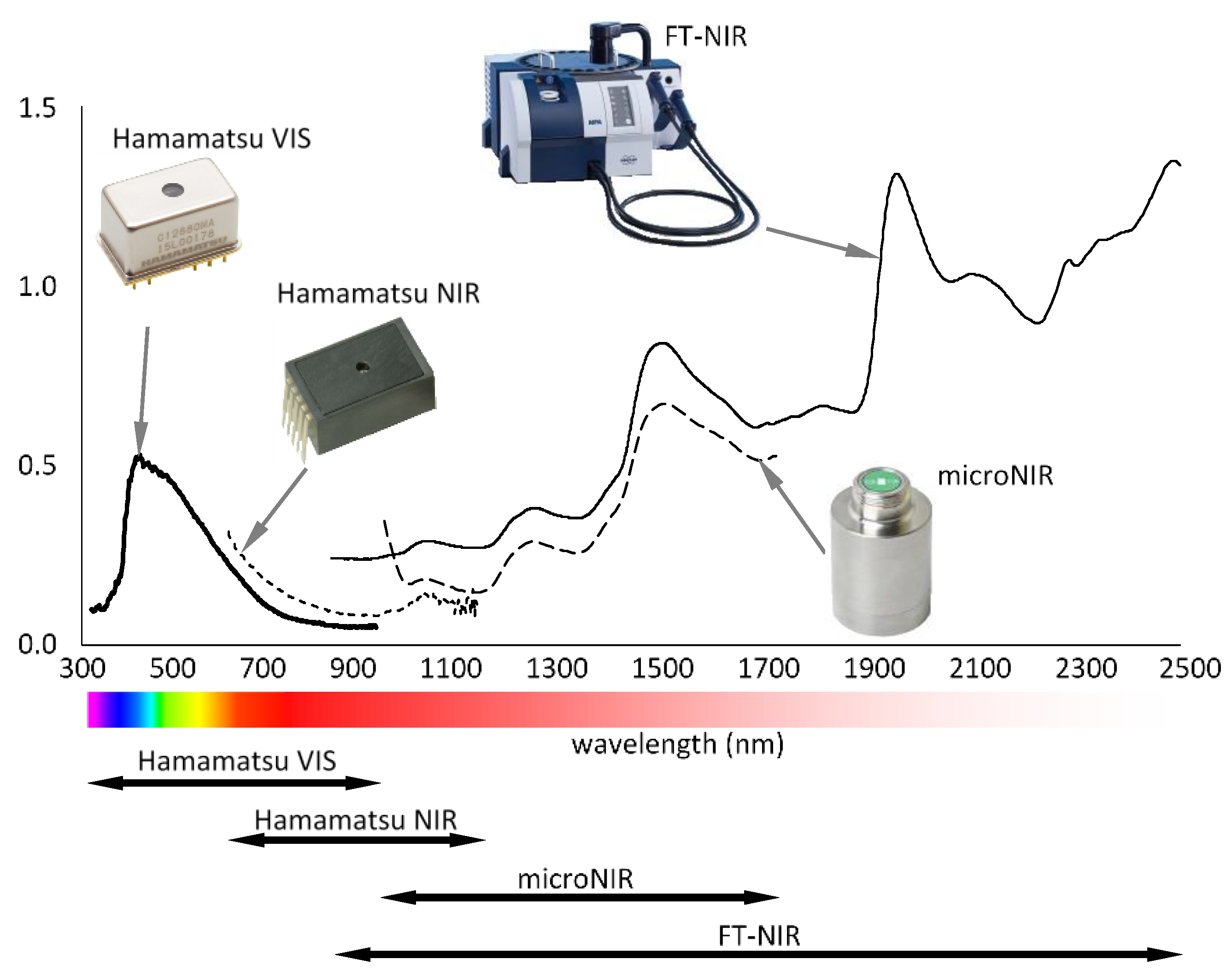
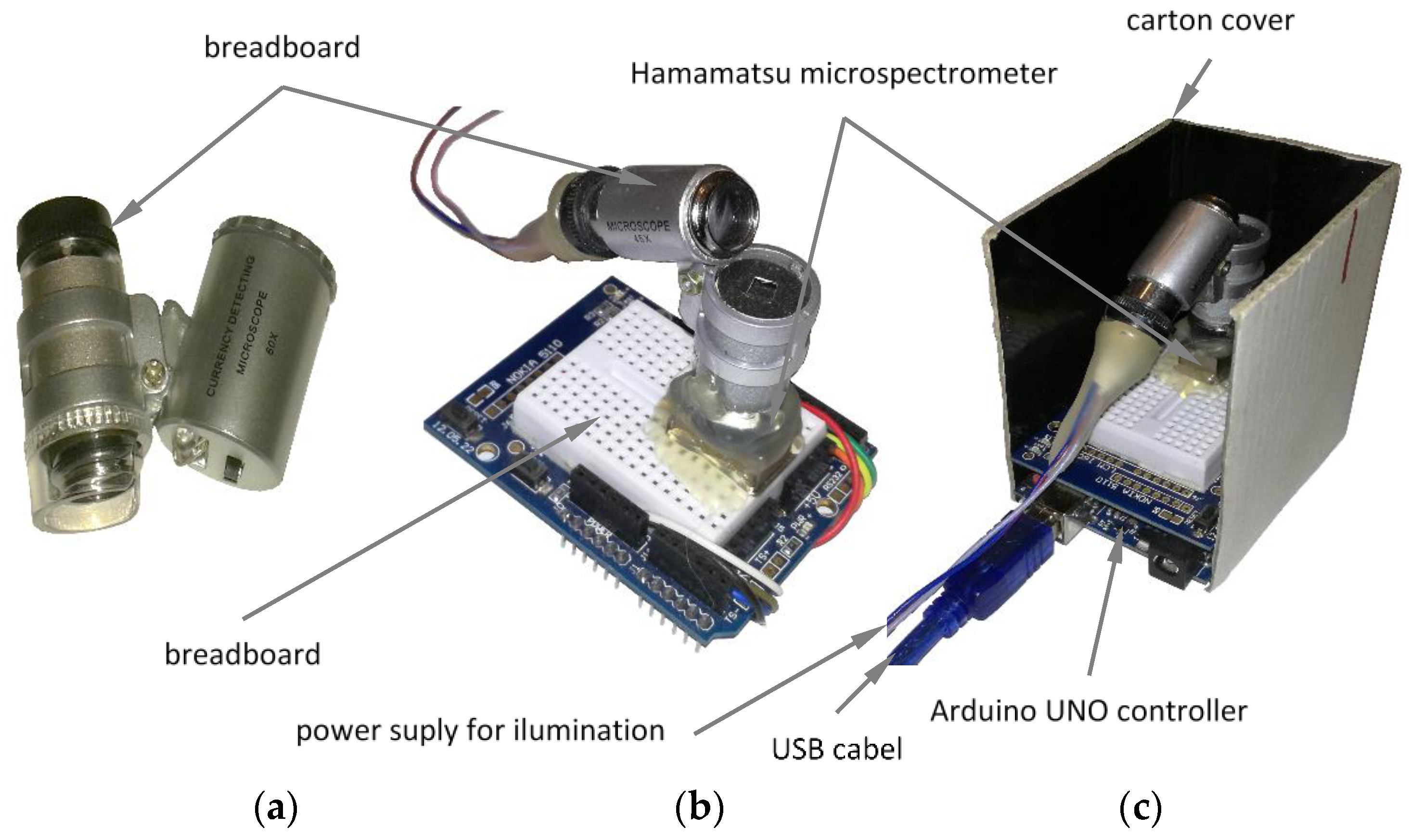
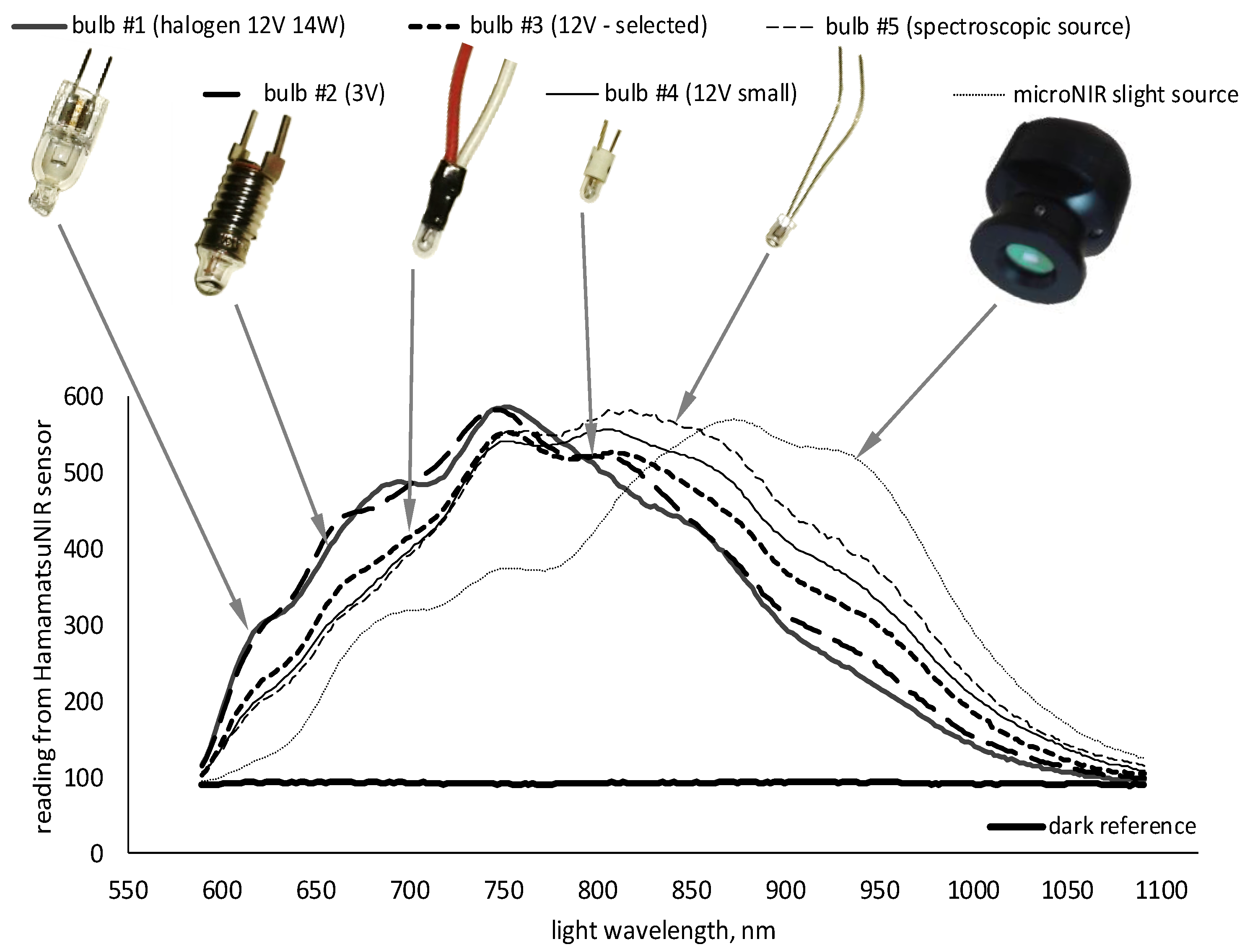
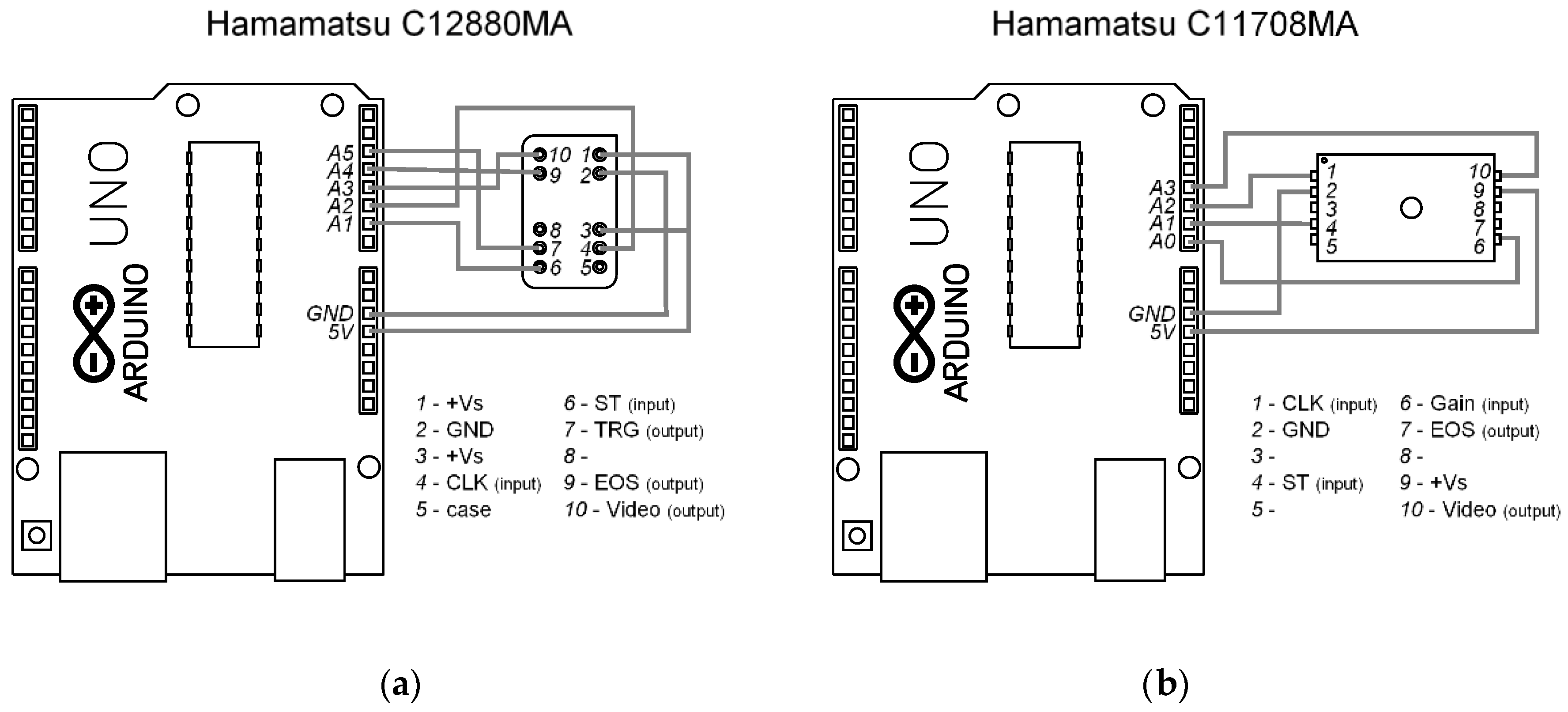

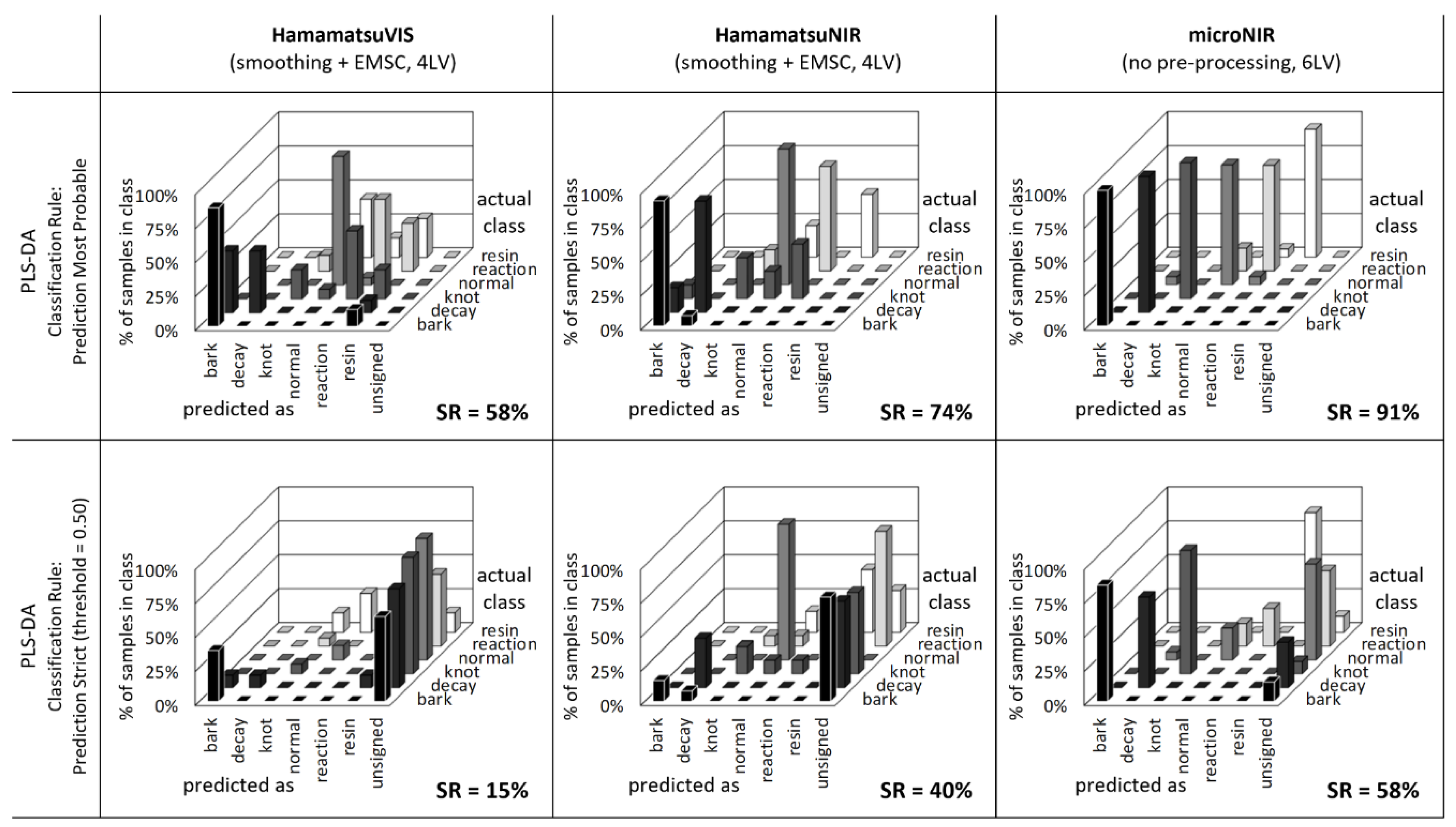

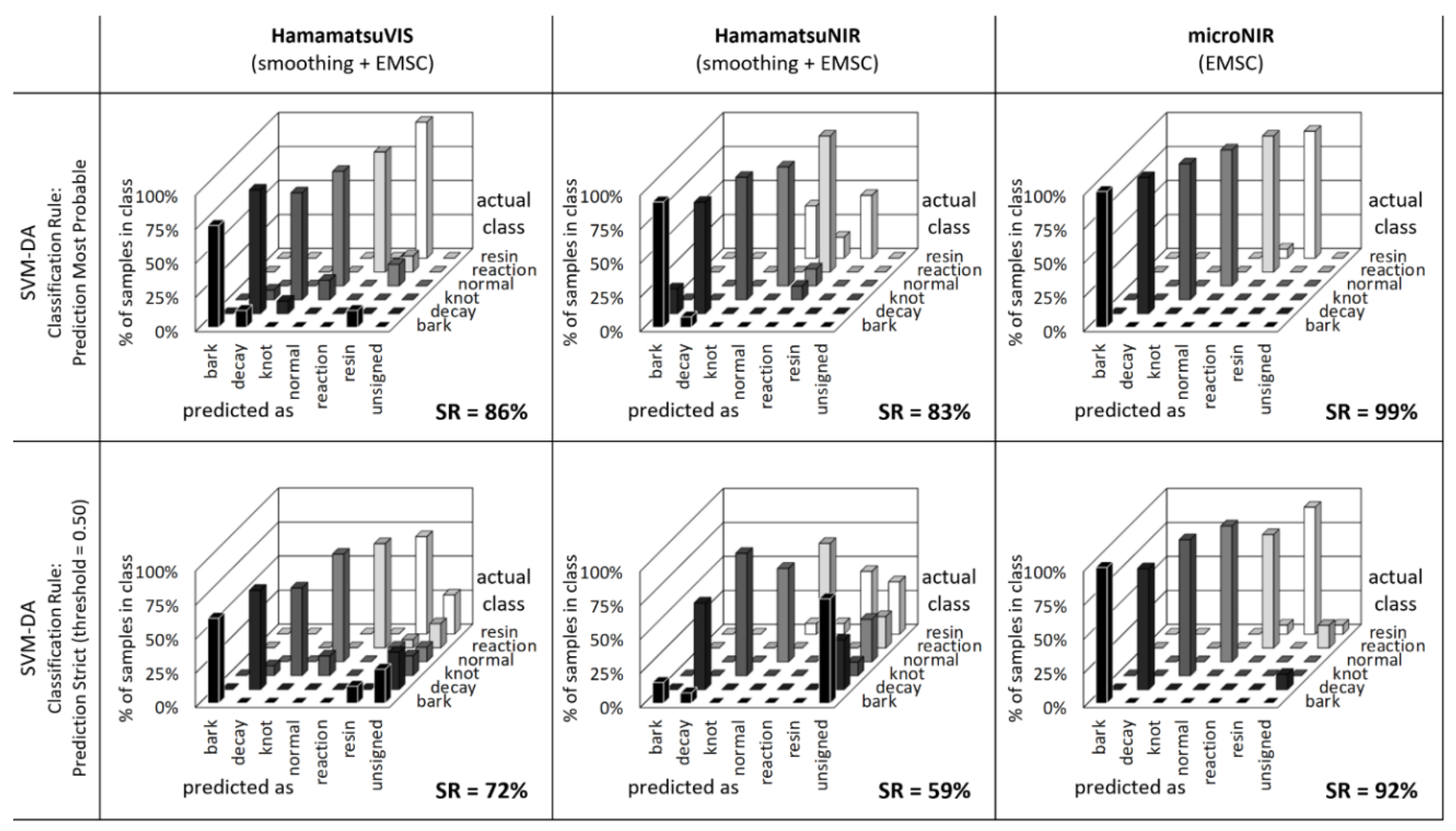
| Bruker MPA | MicroNIR Pro 1700 | Hamamatsu NIR C11708MA | Hamamatsu VIS C12666MA | |
|---|---|---|---|---|
| sensor technology | FT (Fourier Transform) | Linear Variable Filter | MEMS micro-electro-mechanical systems | MEMS micro-electro-mechanical systems |
| range (nm) | 833–2500 | 950–1650 | 640–1050 | 340–780 |
| resolution (nm) | 0.8 | 6.2 | 20 | 15 |
| weight (g) | 15,000 | 64 | 9 | 5 |
| portable | no | yes | yes | yes |
| instrument available on the market | yes | yes | no | no |
| measurement time (s) for a single spectrum | 30 | 0.05–0.5 | 0.05–0.5 | 0.05–0.5 |
| Wavenumber (cm−1) | Wavelength (nm) | Wood Component | Functional Group | |
|---|---|---|---|---|
| 1 | 4198 | 2382 | holocellulose | CH |
| 2 | 4280 | 2336 | cellulose | CH, CH2 |
| 3 | 4404 | 2270 | cellulose, hemicellulose | CH, CH2, OH, CO |
| 4 | 4620 | 2164 | cellulose, hemicellulose | OH, CH |
| 5 | 4890 | 2044 | cellulose semicrystalline and crystalline | OH, CH |
| 6 | 5219 | 1916 | water | OH |
| 7 | 5464 | 1830 | cellulose semicrystalline and crystalline | C=O |
| 8 | 5587 | 1790 | cellulose semicrystalline and crystalline | CH |
| 9 | 5700 | 1754 | extractives | CH2 |
| 10 | 5800 | 1724 | hemicellulose (furanose/pyranose) | CH |
| 11 | 5812 | 1720 | extractives | CH2 |
| 12 | 5883 | 1700 | hemicellulose | CH |
| 13 | 5909 | 1692 | extractives | CH |
| 14 | 5980 | 1672 | lignin | CH |
| 15 | 6117 | 1635 | extractives | CH2 |
| 16 | 6287 | 1590 | cellulose crystalline | OH |
| 17 | 6450 | 1550 | cellulose crystalline | OH |
| 18 | 6722 | 1487 | cellulose semicrystalline | OH |
| 19 | 6785 | 1474 | cellulose | OH |
| 20 | 7008 | 1426 | amorphous cellulose/water | OH |
| 21 | 7309 | 1368 | aliphatic chains | CH |
| 22 | 7344 | 1361 | extractives | CH |
| 23 | 7418 | 1348 | aliphatic chains | CH |
© 2020 by the authors. Licensee MDPI, Basel, Switzerland. This article is an open access article distributed under the terms and conditions of the Creative Commons Attribution (CC BY) license (http://creativecommons.org/licenses/by/4.0/).
Share and Cite
Sandak, J.; Sandak, A.; Zitek, A.; Hintestoisser, B.; Picchi, G. Development of Low-Cost Portable Spectrometers for Detection of Wood Defects. Sensors 2020, 20, 545. https://doi.org/10.3390/s20020545
Sandak J, Sandak A, Zitek A, Hintestoisser B, Picchi G. Development of Low-Cost Portable Spectrometers for Detection of Wood Defects. Sensors. 2020; 20(2):545. https://doi.org/10.3390/s20020545
Chicago/Turabian StyleSandak, Jakub, Anna Sandak, Andreas Zitek, Barbara Hintestoisser, and Gianni Picchi. 2020. "Development of Low-Cost Portable Spectrometers for Detection of Wood Defects" Sensors 20, no. 2: 545. https://doi.org/10.3390/s20020545
APA StyleSandak, J., Sandak, A., Zitek, A., Hintestoisser, B., & Picchi, G. (2020). Development of Low-Cost Portable Spectrometers for Detection of Wood Defects. Sensors, 20(2), 545. https://doi.org/10.3390/s20020545








